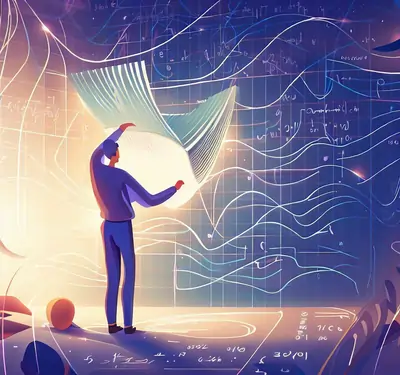The Curvature Tensor: Understanding its Significance in Differential Geometry

Differential geometry is a branch of mathematics that studies the properties of curves and surfaces in space, using tools from calculus and linear algebra. One of the fundamental concepts in differential geometry is the curvature of a curve or surface. Curvature provides essential information about the shape and geometry of objects and plays a crucial role in various fields, including physics, engineering, and computer graphics. In this blog, we will delve into the concept of the curvature tensor, a powerful mathematical tool that helps us understand the curvature of curves and surfaces in a more profound way. If you're looking to complete your differential geometry assignment, understanding the curvature tensor is a key step in mastering this fascinating field.
Understanding Curvature in Differential Geometry
Before we dive into the curvature tensor, let's briefly review the concept of curvature in differential geometry.
Curvature of Curves
In the context of curves, curvature measures how much a curve deviates from being a straight line at a given point. It quantifies the rate at which the tangent vector to the curve changes as you move along the curve. For a parametric curve in three-dimensional space, γ(t)=(x(t),y(t),z(t)), the curvature κ is defined as:

κ=∥r′(t)∥∥T′(t)∥
Where:
- T(t) is the unit tangent vector to the curve.
- r′(t) is the velocity vector of the curve.
- ∥v∥ denotes the magnitude of vector v.
Curvature of Surfaces
When dealing with surfaces in three-dimensional space, curvature becomes more intricate. Surfaces can exhibit curvature in two principal directions: the principal curvatures. These curvatures are represented as 1κ1 and 2κ2 and characterize the curvature of the surface along its orthogonal directions.
Now, let's move on to the main topic of this blog: the curvature tensor.
Introducing the Curvature Tensor
The curvature tensor, often denoted as Rijkl, is a mathematical object used in the field of differential geometry to describe the curvature properties of Riemannian manifolds. A Riemannian manifold is a space that locally resembles Euclidean space, and the curvature tensor helps us understand how the geometry of such spaces deviates from flat Euclidean geometry.
The curvature tensor contains valuable information about the curvature of a manifold and its behavior in different directions. It's a multidimensional array of numbers that encode the intrinsic curvature properties of the space. To comprehend its significance, let's break down its components and explore its various applications.
Components of the Curvature Tensor
The curvature tensor, often denoted as Rijkl, is a multidimensional array of numbers that characterizes the curvature properties of a Riemannian manifold. Let's break down its components step by step:
- The Metric Tensor gij:
- The Riemann Curvature Tensor Rjklm:
To understand the curvature tensor, we must first introduce the metric tensor gij. The metric tensor encodes the local geometry of the manifold. It defines the inner product between tangent vectors at each point on the manifold. In other words, it tells us how distances and angles work in this curved space.
The curvature tensor Rijkl is defined in terms of the Riemann curvature tensor Rjklm. These components are computed with respect to the Levi-Civita connection, which is a compatible connection on a Riemannian manifold. The components of the Riemann curvature tensor Rjklm represent the rate at which the basis vectors (coordinate vector fields) change as they are parallel transported along small loops on the manifold. In essence, they quantify the intrinsic curvature of the manifold.
Now, let's delve into the significance of these components:
Significance of the Components
- Metric Tensor gij:
- Local Geometry: The components of the metric tensor (gij) define the local geometry of the manifold. They specify how lengths and angles are measured in the curved space. This information is essential for understanding how the manifold deviates from flat Euclidean space.
- Geodesics: The metric tensor is also used to compute geodesics, which are the shortest paths between points on the manifold. Geodesics are analogous to straight lines in flat space but are curved due to the manifold's intrinsic geometry. The metric tensor provides the necessary information for calculating geodesic equations.
- Riemann Curvature Tensor Rjklm:
- Intrinsic Curvature: The components of the Riemann curvature tensor (Rjklm) capture the intrinsic curvature of the manifold. They describe how the basis vectors change as they are transported around closed loops on the manifold. If the components are nonzero, it indicates the presence of curvature.
- Curvature in Different Directions: The components of Rjklm provide insight into how the curvature varies in different directions on the manifold. In particular, they reveal whether the curvature is positive (indicating a convex curvature), negative (indicating a concave curvature), or zero (indicating flatness) in different directions.
- Gravitational Effects: In the context of general relativity, the Riemann curvature tensor is critical for understanding the gravitational effects caused by massive objects. It quantifies the curvature of spacetime, which, in turn, dictates the motion of objects under the influence of gravity. The components of the curvature tensor are used to compute the Ricci tensor and, subsequently, the Einstein tensor, which are essential in Einstein's field equations describing gravity.
- Topological Invariants: The components of the curvature tensor are also used in algebraic topology to calculate topological invariants of manifolds. These invariants capture essential topological properties and are crucial for distinguishing different types of spaces in topology. The curvature tensor helps bridge the gap between geometry and topology.
In summary, the components of the curvature tensor are the building blocks that encode the intrinsic curvature information of a Riemannian manifold. They provide insights into the local geometry of the space, the behavior of geodesics, the presence of curvature in different directions, and even the gravitational effects in general relativity. Understanding these components is essential for gaining a deep appreciation of the geometry and physics of curved spaces.
Significance of the Curvature Tensor
The curvature tensor is a fundamental tool in differential geometry with several key applications and significance:
- Geodesic Deviation and General Relativity:
- Shape Analysis and Computer Graphics:
- Differential Forms and Mathematical Theories:
- Ricci and Einstein Tensors in General Relativity:
- Topological Invariants and Algebraic Topology:
In Albert Einstein's theory of general relativity, the curvature tensor takes center stage. It plays a pivotal role in explaining the fundamental concept of gravity as the curvature of spacetime. According to general relativity, massive objects create curvature in the fabric of spacetime around them. Objects in free-fall, following geodesic paths, move along the curved spacetime under the influence of gravity. The curvature tensor is indispensable for understanding the deviation of geodesics, which helps explain phenomena like the bending of light by massive objects (gravitational lensing) and the precession of planetary orbits.
In computer graphics and computer vision, the curvature tensor is a valuable tool for shape analysis and object recognition. When creating 3D models or analyzing real-world objects using computer vision algorithms, understanding the local geometry is essential. The curvature tensor aids in identifying and characterizing the shape of surfaces, which is crucial for tasks like object recognition, 3D reconstruction, and image segmentation. It helps distinguish between flat regions, ridges, valleys, and other intricate surface features.
In the domain of mathematical theories, such as differential geometry, the curvature tensor plays a vital role in defining and computing differential forms. Differential forms are mathematical objects used to describe various geometric and physical quantities. They are essential for understanding the structure of manifolds and provide a unified framework for expressing various physical laws. The curvature tensor is a fundamental ingredient in defining these forms, making it a cornerstone in the development of mathematical theories related to connections, curvature, and differential geometry.
The curvature tensor is instrumental in deriving two crucial tensors in the field of general relativity: the Ricci tensor (Rij) and the Einstein tensor (Gij). The Ricci tensor encapsulates the local gravitational effects in a region of spacetime, and the Einstein tensor combines it with the metric tensor to formulate Einstein's field equations. These equations describe the gravitational field and the curvature of spacetime in the presence of matter and energy. Thus, the curvature tensor serves as the foundation upon which Einstein's theory of gravity is built.
The curvature tensor finds its way into the realm of algebraic topology, where it is used to compute topological invariants of manifolds. Topological invariants are mathematical quantities that capture essential topological properties of spaces, regardless of their specific geometric features. Examples of such invariants include the Euler characteristic and Pontryagin classes. The curvature tensor provides a powerful tool for calculating these invariants, which are crucial for classifying and distinguishing different types of spaces in topology.
In conclusion, the curvature tensor is not merely a mathematical abstraction but a cornerstone concept with wide-ranging significance across mathematics, physics, and engineering. From explaining gravity and shaping the field of general relativity to aiding in computer graphics and topology, its applications touch virtually every corner of modern science and mathematics. Its importance lies not only in its theoretical elegance but also in its practical utility, making it a fundamental tool for understanding the curvature of the universe and the geometry of the world around us.
Curvature Tensor and Gauss-Bonnet Theorem
One of the most famous results involving the curvature tensor is the Gauss-Bonnet theorem. This theorem relates the curvature of a two-dimensional surface to its topological properties. Specifically, it states that the integral of the Gaussian curvature over a closed surface is equal to 2π times the Euler characteristic of the surface:
∫∫SKdA=2πχ(S)
Where:
- K is the Gaussian curvature of the surface.
- χ(S) is the Euler characteristic of the surface.
The Gauss-Bonnet theorem provides a deep connection between geometry and topology and is a fundamental result in both fields.
Curvature Tensor in Practical Applications
The concept of the curvature tensor finds applications in various scientific and engineering disciplines. Here are a few practical examples:
- General Relativity: In Einstein's theory of general relativity, the curvature tensor describes the curvature of spacetime caused by the presence of mass and energy. This theory has been confirmed through numerous experiments and observations and is the foundation of modern astrophysics.
- Robotics and Path Planning: In robotics, understanding the curvature of surfaces is crucial for path planning and obstacle avoidance. Robots need to navigate smoothly through their environment, and knowledge of the local curvature helps in achieving this.
- Material Science: In the study of materials, especially in the design of advanced composites and nanostructures, curvature properties are crucial for predicting mechanical behavior and optimizing material performance.
- Medical Imaging: Curvature analysis is used in medical imaging to study the shape and geometry of biological structures, such as bones, blood vessels, and brain surfaces. It has applications in diagnosis, treatment planning, and surgical guidance.
Conclusion
The curvature tensor is a powerful mathematical concept with profound implications in the study of geometry, physics, and various other fields. It provides a comprehensive framework for understanding the intrinsic curvature of Riemannian manifolds and plays a central role in the formulation of Einstein's theory of general relativity. Its applications extend far beyond theoretical mathematics, finding practical use in robotics, material science, and medical imaging. The study of the curvature tensor continues to be a fascinating and essential topic in the realm of differential geometry, contributing to our understanding of the universe and the world around us.